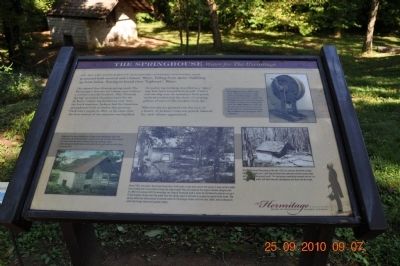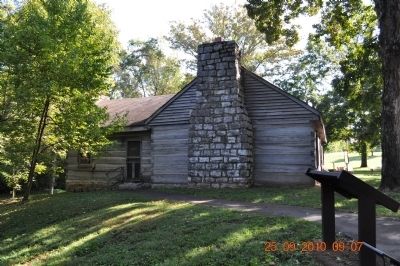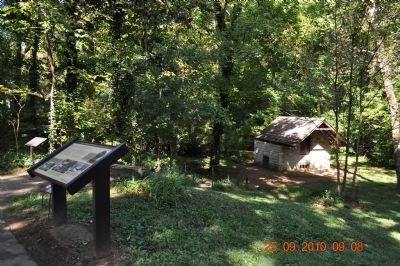Hermitage in Davidson County, Tennessee — The American South (East South Central)
The Springhouse
Water for The Hermitage
Two natural free-flowing springs made The Hermitage a fine site for a farm, even without a coveted riverside location. This “Gravelly Spring” provided abundant water for the Jacksons' simple log farmhouse and, later, the brick mansion. Jackson had the limestone springhouse built to shelter this precious fresh water supply in 1821, at the same time the first version of the mansion was finished.
An earlier log building described as a “dairy” may have been located here as well. Until a well was dug near the mansion’s back porch, enslaved workers had the chore of carrying gallons of water to the mansion every day.
What we take for granted with the turn of a faucet, in Jackson’s time was prized, labored for, and—always—appreciated.
Topics. This historical marker is listed in these topic lists: Agriculture • Settlements & Settlers • Waterways & Vessels. A significant historical year for this entry is 1821.
Location. 36° 13.022′ N, 86° 36.753′ W. Marker is in Hermitage, Tennessee, in Davidson County. Marker can be reached from Rachels Lane, 0.3 miles east of Hermitage Road. Touch for map. Marker is at or near this postal address: 4580 Rachels Lane, Hermitage TN 37076, United States of America. Touch for directions.
Other nearby markers. At least 8 other markers are within walking distance of this marker. Field Quarter Trail (here, next to this marker); Cabin-by-the-Spring (a few steps from this marker); Property, Family, Humanity (within shouting distance of this marker); The Hunter’s Hill Farm Building (within shouting distance of this marker); The First Hermitage (about 300 feet away, measured in a direct line); A Future President's Home (about 300 feet away); The Hermitage Landscape (about 400 feet away); Growing Cotton (about 400 feet away). Touch for a list and map of all markers in Hermitage.
Also see . . . The Hermitage, The Home of President Andrew Jackson. (Submitted on February 10, 2012, by Bernard Fisher of Richmond, Virginia.)
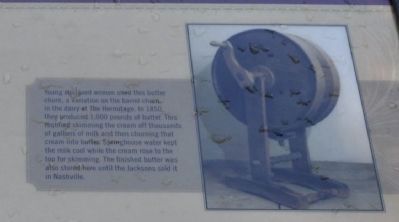
Photographed By Sandra Hughes, September 25, 2010
4. Butter Churn
Young enslaved women used this butter churn, a variation on the barrel churn, in the dairy at The Hermitage. In 1850, they produced 1,000 pounds of butter. This required skimming the cream off thousands of gallons of milk and then churning that cream into butter. Springhouse water kept the milk cool while the cream rose to the top for skimming. The finished butter was also stored here until the Jackson’s sold it in Nashville.
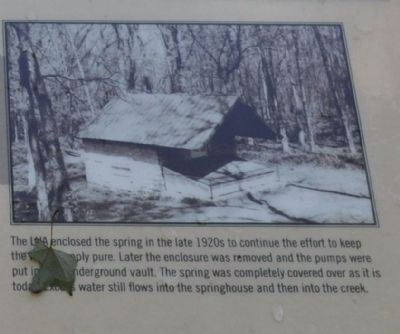
Photographed By Sandra Hughes, September 25, 2010
5. The Springhouse
The LHA enclosed the spring in the late 1920s to continue the effort to keep the water supply pure. Later the enclosure was removed and the pumps were put in an underground vault. The spring was completely covered as it is today and water still flows into the springhouse and then into the creek.
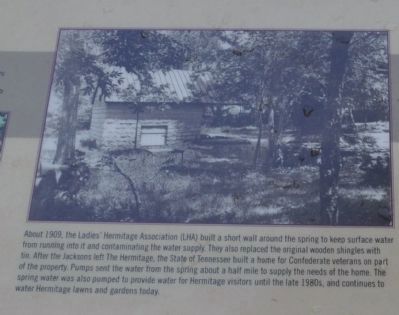
Photographed By Sandra Hughes, September 25, 2010
6. The Springhouse
About 1909, the Ladies’ Hermitage Association (LHA) built a short wall around the spring to keep surface water from running into it and contaminating the water supply. They also replaced the original wooden shingles with tin. After the Jackson’s left The Hermitage, the State of Tennessee built a home for Confederate veterans on part of the property. Pumps sent the water from the spring about a half mile to supply the needs of the home. The spring water was also pumped to provide water for Hermitage visitors until the late 1980s, and continues to water the Hermitage lawns and gardens today.
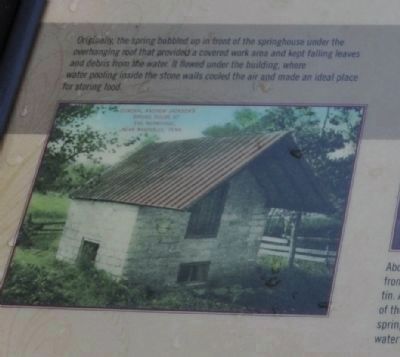
Photographed By Sandra Hughes, September 25, 2010
7. The Springhouse
Originally, the spring bubbled up in front of the springhouse under the overhanging roof that provided a covered work area and kept falling leaves and debris from the water. It flowed under the building, where water pooling inside the stonewalls cooled the air and made an ideal place for storing food.
Credits. This page was last revised on February 7, 2023. It was originally submitted on February 9, 2012, by Sandra Hughes Tidwell of Killen, Alabama, USA. This page has been viewed 633 times since then and 9 times this year. Last updated on March 13, 2015, by J. Makali Bruton of Accra, Ghana. Photos: 1, 2, 3, 4, 5, 6, 7. submitted on February 9, 2012, by Sandra Hughes Tidwell of Killen, Alabama, USA. • Bill Pfingsten was the editor who published this page.
